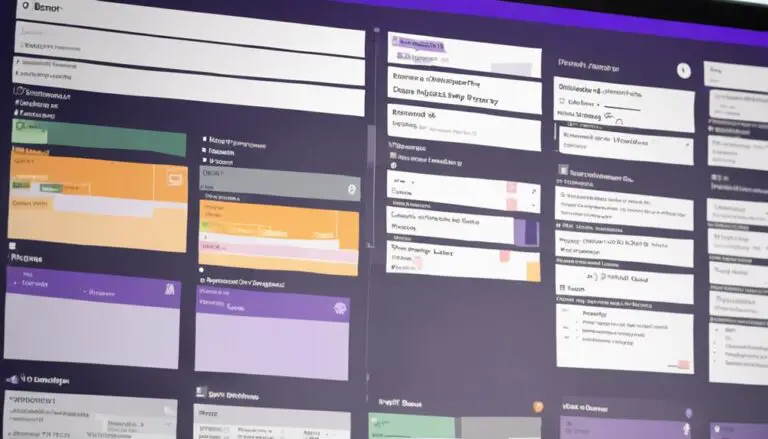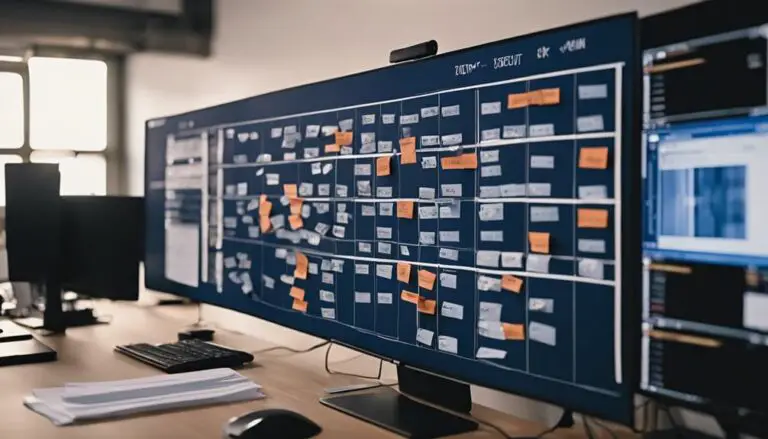Imagine a well-orchestrated symphony where each instrument plays its part seamlessly, creating a harmonious melody.
When it comes to Kanban boards and sprints, the relationship between them might not be as straightforward as you think.
While Kanban boards are known for their fluidity and focus on continuous flow, the concept of sprints introduces a structured time-bound element.
How do these two seemingly contrasting methodologies merge, and what benefits can this hybrid approach offer?
Key Takeaways
- Kanban boards can incorporate sprint-like iterations for specific objectives.
- Sprints in Kanban offer focused task completion and enhanced productivity.
- Combining Kanban with sprints fosters structured goal achievement.
- Utilizing sprints in Kanban enhances accountability, collaboration, and workflow optimization.
Understanding Kanban Boards
In understanding Kanban boards, you'll observe a system that visualizes workflow effectively by managing tasks through designated columns on the board. Each column represents a different stage of progress for the tasks, allowing for a clear visual representation of where each task stands. This method not only aids in task management but also promotes continuous improvement within the workflow.
The columns on a Kanban board serve as a guide for the tasks, ensuring flow efficiency and providing flexibility in managing and prioritizing work items. Unlike Agile sprints, Kanban boards don't have fixed time constraints, allowing for changing priorities to be accommodated seamlessly without the pressure of strict deadlines. This adaptability is a key feature of Kanban boards, enabling teams to adjust their focus based on the current needs of the project while maintaining a steady pace of progress towards completion.
Exploring Agile Sprints in Kanban
Exploring Agile Sprints within the context of Kanban reveals a unique approach to project management that combines the principles of continuous flow with time-bound iterations. While Kanban doesn't have sprints in the traditional sense, it shares similarities with Agile methodologies in promoting continuous workflow.
Kanban focuses on visualizing your work and limiting work-in-progress (WIP) to maintain a steady and balanced flow of tasks. In contrast to Scrum, Kanban doesn't use predefined sprint goals or fixed timeframes. Instead, teams working with Kanban pull work as capacity allows, ensuring a more flexible approach to project management.
Incorporating Sprints in Kanban Workflow
Within Kanban workflows, teams can introduce sprint-like iterations to focus on specific objectives or deliverables within a defined time frame, enhancing productivity and feedback cycles.
When incorporating sprints in Kanban, the project manager or Scrum Master may facilitate Sprint Planning, where the team collaborates to define goals and select items from the backlog to form a sprint backlog.
Throughout the sprint, Teams Members limit their work-in-progress (WIP) items, aiming to complete tasks within the sprint's duration. By visualizing tasks on a board to visualize progress, the team can effectively manage their cycle time and ensure a steady flow of work.
This approach allows for a structured way to achieve goals within a fixed timeframe, combining the flexibility of Kanban with the time-boxed nature of sprints. The Scrum Product Owner may also play a role in setting priorities and ensuring the team focuses on delivering the most valuable work during these sprint-like iterations.
Benefits of Sprints in Kanban
Utilizing sprints in Kanban brings about a focused approach to task completion and enhanced productivity within the team. By setting specific goals and deadlines, sprints help create structured intervals for work, fostering a sense of accountability and collaboration among team members. The structured approach of sprints within Kanban workflow enables teams to prioritize effectively, optimize workflows, and continuously improve their processes.
Feedback from sprint deliverables plays a crucial role in fine-tuning the workflow and ensuring that the team stays on track towards achieving their goals. This feedback loop not only enhances the quality of work but also aids in better decision-making and resource allocation within the team.
Moreover, the incorporation of sprints in Kanban can significantly boost productivity by breaking down complex tasks into manageable units, making them easier to tackle. The collaborative nature of sprints encourages team members to work together towards a common objective, fostering a sense of unity and shared accomplishment.
Best Practices for Kanban Boards and Sprints
To optimize the use of Kanban boards and sprints effectively, understanding their distinct roles and best practices is crucial for successful project management.
Kanban boards excel in visualizing work progress through columns, promoting a continuous workflow. In contrast, sprints, belonging to Agile Scrum, emphasize concentrated work intervals within defined iterations.
The best practice often involves utilizing Kanban for continuous improvement and Scrum for iterative development, leveraging the strengths of each approach. Recognizing the differences between sprints and Kanban boards is essential for effective project management, enabling teams to select the most suitable methodology based on project requirements.
Frequently Asked Questions
Does Kanban Board Have Sprints?
In Kanban, boards don't have sprints. Instead, tasks flow continuously without fixed durations or sprint planning. You manage work visually, adapting task completion and priorities flexibly. Kanban gives real-time progress visibility, enhancing flow efficiency for teams.
How Do I Manage Sprints in Kanban Board?
To manage sprints in a Kanban board, start by sprint planning, task prioritization, and time tracking. Organize tasks with work in progress limits and visualize workflows. Encourage team collaboration and focus on continuous improvement to optimize cycle and lead times.
Do You Have Sprint Reviews in Kanban?
In Kanban, you don't have sprint reviews. Instead, focus on Kanban efficiency, Agile methodology, continuous improvement, team collaboration, work in progress, task prioritization, Lean principles, and workflow optimization. Kanban emphasizes flow over time-boxed iterations.
What Is the Goal of the Sprint in Kanban?
In Kanban, the goal of the sprint is to enhance sprint efficiency, foster team collaboration, promote continuous improvement, optimize workflow, prioritize tasks, reduce cycle time, manage work in progress, increase delivery speed, and achieve incremental delivery.
Conclusion
Congratulations! You've learned that while Kanban boards typically don't have sprints, they can actually benefit from incorporating them. Many teams find that integrating sprints into their Kanban process helps to provide a cadence for planning and delivery, as well as a structured time frame for reviewing and improving processes. In fact, this approach, known as ‘how kanban teams use sprints‘, allows teams to take advantage of the flexibility of Kanban while also implementing some of the beneficial aspects of sprint-based methodologies. By incorporating sprints, teams can maintain a continuous flow of work while still having designated periods for focused collaboration and refinement.
Imagine the irony of adding structured time-boxed iterations to a flexible workflow system.
By combining the visual efficiency of Kanban with the goal-oriented focus of sprints, you can create a dynamic and productive workflow that will keep your team on track and moving forward.
Keep exploring and experimenting to find the perfect balance for your projects!





